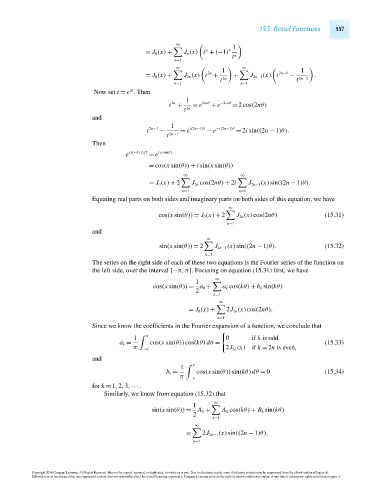Page 577 - Advanced_Engineering_Mathematics o'neil
P. 577
15.3 Bessel Functions 557
∞
1
n
= J 0 (x) + J n (x) t + (−1) n
t n
n=1
∞
∞
1 1
2n 2n−1
= J 0 (x) + J 2n (x) t + + J 2n−1 (x) t − .
t 2n t 2n−1
n=1 n=1
iθ
Now set t = e . Then
1
2n 2inθ −2inθ
t + = e + e = 2cos(2nθ)
t 2n
and
1
t 2n−1 − = e i(2n−1)θ − e −i(2n−1)θ = 2i sin((2n − 1)θ).
t 2n−1
Then
e x(t−1/t)/2 = e ix sin(θ)
= cos(x sin(θ)) + i sin(x sin(θ))
∞ ∞
= J 0 (x) + 2 J 2n cos(2nθ) + 2i J 2n−1 (x)sin((2n − 1)θ).
n=1 n=1
Equating real parts on both sides and imaginary parts on both sides of this equation, we have
∞
cos(x sin(θ)) = J 0 (x) + 2 J 2n (x)cos(2nθ) (15.31)
n=1
and
∞
sin(x sin(θ)) = 2 J 2n−1 (x)sin((2n − 1)θ). (15.32)
n=1
The series on the right side of each of these two equations is the Fourier series of the function on
the left side, over the interval [−π,π]. Focusing on equation (15.31) first, we have
∞
1
cos(x sin(θ)) = a 0 + a k cos(kθ) + b k sin(kθ)
2
k=1
∞
= J 0 (x) + 2J 2n (x)cos(2nθ).
n=1
Since we know the coefficients in the Fourier expansion of a function, we conclude that
1 π 0 if k is odd
a k = cos(x sin(θ))cos(kθ)dθ = (15.33)
π −π 2J 2n (x) if k = 2n is even,
and
1 π
b k = cos(x sin(θ))sin(kθ)dθ = 0 (15.34)
π −π
for k = 1,2,3,···.
Similarly, we know from equation (15.32) that
∞
1
sin(x sin(θ)) = A 0 + A k cos(kθ) + B k sin(kθ)
2
k=1
∞
= 2J 2n−1 (x)sin((2n − 1)θ).
n=1
Copyright 2010 Cengage Learning. All Rights Reserved. May not be copied, scanned, or duplicated, in whole or in part. Due to electronic rights, some third party content may be suppressed from the eBook and/or eChapter(s).
Editorial review has deemed that any suppressed content does not materially affect the overall learning experience. Cengage Learning reserves the right to remove additional content at any time if subsequent rights restrictions require it.
October 14, 2010 15:20 THM/NEIL Page-557 27410_15_ch15_p505-562

